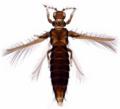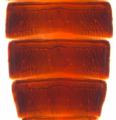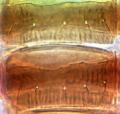Selenothrips rubrocinctus
Recognition data
Distinguishing features
Both sexes fully winged. Body blackish brown, tarsi and apices of tibiae yellow; antennal segments III–V yellow at least in basal half; fore wing uniformly dark with black setae. Head with transverse reticulation, cheeks sharply constricted to basal neck; ocellar setae on anterior margins of triangle. Antennae 8-segmented, III–IV constricted into neck at base and apex, sensorium long and forked; VIII longer than VII. Pronotum with transverse lines of sculpture, no prominent poster-angular setae, but 1 pair of long anteromarginal setae. Mesonotum with transverse reticulation, lateral setae minute. Metanotum with median triangle enclosing transverse reticulation, with 1 pair of setae on anterior half. Tarsi 1-segmented. Metathoracic furca elongate and forked. Fore wing with long costal setae, two irregular rows of veinal setae, postero-marginal cilia wavy. Abdominal tergites with lateral thirds reticulate; IV–VIII with median setae longer than distance between their bases; VIII with complete comb of long microtrichia; tergite X without longitudinal division. Sternites with three pairs of long marginal setae.
Male sternites III–VII with small oval pore plate on antecostal ridge.
Related and similar species
Not yet recorded in California, but nevertheless a potential immigrant, this is the only species recognized in the genus Selenothrips. An African species, Xestothrips glabratus (Priesner), has been associated with this genus (Wilson, 1957), but lacks sculpture on the head and pronotum.
Taxonomic data
Current valid name
Selenothrips rubrocinctus (Giard)
Original name and synonyms
- Physopus rubrocinctus Giard, 1901: 263
- Heliothrips (Selenothrips) decolor Karny, 1911: 179
- Heliothrips (Selenothrips) mendex Schmutz, 1913: 994
- Brachyurothrips indicus Bagnall, 1926: 98
Family placement
Thripidae, Panchaetothripinae
Common names
Red banded cacao thrips
Biological data
Life history
Larvae and adults feed on the leaves of many plants, and pupae also can be found on leaves.
Host plants
On the mature leaves of Theobroma cacao (Sterculiaceae), Mangifera indica (Anacardiaceae), Persea spp.(Lauraceae), and many other trees, but not usually on young leaves.
Tospoviruses vectored
None
Crop damage
Leaf damage to tree crops, sometimes in association with water stress (Fennah, 1965).
Distribution data
Area of origin
Possibly Africa.
Distribution
Widespread in tropical and subtropical countries.









